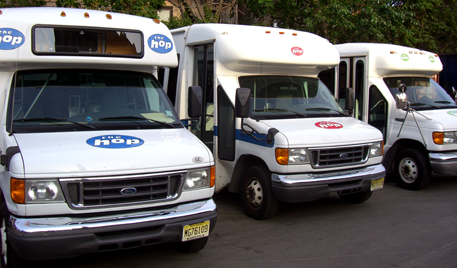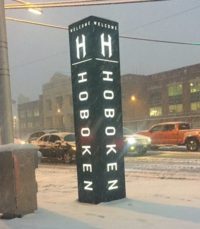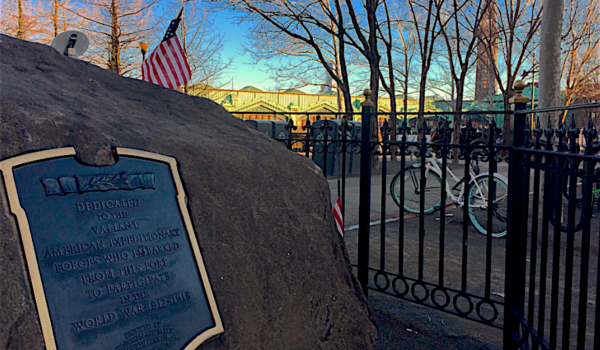
Hoboken Hopes to Restore Flow to Local Business Through Parking & Transportation Initiatives
Despite a surging, visible influx of wealth to the Mile Square City, Hoboken’s small businesses continue to face adversity in an ever-evolving marketplace. Online retailer dominance, demographic shifts impacting hospitality, long-term construction projects and complex parking issues have colluded to make the small business landscape in town debilitating to some businesses, and outright fatal to others.

“Two major priorities in Hoboken are parking,” said Mayor Ravi S. Bhalla, “and, one that has been especially acute in the last five to ten years, is small businesses—maintaining a vibrant small business economy.”
Bhalla spoke with hMAG on Monday afternoon to discuss new parking and transportation initiatives that look to reinvigorate small businesses here in town. “As Mayor, I’d like to see what we could do to address both of those issues because, to some extent, I do think they are interrelated.”
The City officially announced plans to launching several parking initiatives intended to improve the overall parking experience in Hoboken. Among the changes are a new and improved “virtual” visitor permit system that allows visitor permits to be purchased and activated online, and the reintroduction of the “Daily Debit Program” to provide cheap, daily garage parking for Hoboken business employees as opposed to taking up on street parking. Additionally, the City is implementing dynamic, market-based pricing throughout Hoboken, while decreasing short-term pricing in Garage B, D and Midtown. Meanwhile, the City will be offering its Hop bus service free of charge, in an effort to curb demand for parking.

Hop on… it’s free!
These initiatives, which were approved by the City Council in November, will be implemented on Monday, March 4.
This is part of what the City is calling a “Parking Benefit District”—a geographic area where parking revenues are collected and reinvested into economic development initiatives designed to attract customers to business districts.
“The idea is to create a 15 percent availability of parking per block—one or two spaces per block at any given time is, aspirationally, what the objective is for people who want to park and utilize small businesses,” said Bhalla. “The problem right now is that there is an imbalance between the pricing structure on-street and the pricing structure off-street. Because the pricing structure is so low on street, people who are not necessarily parking to shop are parking on-street for the better part of the day, which lowers the opportunity for customers to utilize the businesses.
Bhalla added, “At the same time, you have garages that are so expensive. If you’re an employee of a small business, you have no incentive to park your car in a garage because in Hoboken you have this quirky dynamic where it’s actually cheaper to park on the real estate that should be used by customers. What we’re trying to do is correct that imbalance by creating more availability for customers by incentivizing employees to utilize garages. Under this new program, if you’re an employee of a business in Hoboken, you can park in the garage for $5 for the whole day.”

On-street parking rates will now be subject to dynamic pricing. Drivers looking to park on the streets of Hoboken will now be charged between $0.50 and $0.90 for 15 minutes—dependent upon location and availability. Furthermore, certain areas of town will see meters run until midnight, with the idea being that ongoing parking enforcement will create a better flow of customers in those zones.
***CLICK HERE for a Map of Hoboken Dynamic Pricing Zones***
“Right now you have a situation where people rush in at 9:00, get their free parking and there’s nowhere in town to park at 10 or 11:00,” says Ryan Sharp, Hoboken’s Director of Parking and Transportation. “This is designed to continue parking turnover and improve parking availability all the way through midnight on a handful of streets that have businesses open late nights most of the week.”
Sharp has been working with others to develop this plan over the past year. “Most cities in this region have similar population densities, density of retail and parking demand as Hoboken—and they have parking rates that are much, much higher,” he told us. “New Jersey has been kind of slow to get in the game, but it’s becoming best practice now in Boston, New York, Philadelphia, DC, San Francisco—even Atlantic City and some other shore towns.”
 Bhalla added, “We’re looking to earmark the revenue generated from the dynamic pricing structure and reinvest it back into the local economy and small business through various improvements that we feel will benefit.”
Bhalla added, “We’re looking to earmark the revenue generated from the dynamic pricing structure and reinvest it back into the local economy and small business through various improvements that we feel will benefit.”
The City expects to invest approximately $250,000 into Parking Benefit District projects in Year 1 with a goal of investing a minimum of $1,000,000 to $2,000,000 over five years. Types of projects that will be eligible for Parking Benefit District funding include public transportation, parking technology and infrastructure (parking app, repairs and modernization of garages, etc.), streetscape improvements (planters, public seating, new signage, etc.), green infrastructure (street trees, rain gardens, etc.), and safety improvements to streets.
“The last thing we want to do is use it to plug a budget gap,” said Bhalla, emphatically. “We want it to be earmarked for this purpose.”
 The plan was reportedly presented to the Hoboken Chamber of Commerce, with the ultimate goal of incorporating the whole of Hoboken into a Special Improvement District (SID) within the next few months—similar to those currently existing in neighboring Jersey City.
The plan was reportedly presented to the Hoboken Chamber of Commerce, with the ultimate goal of incorporating the whole of Hoboken into a Special Improvement District (SID) within the next few months—similar to those currently existing in neighboring Jersey City.
“My overarching goal is to help small businesses, because they’re under attack,” said Bhalla. “The backbone of any vibrant city is the streetscape, the street life. The government’s job is to play a supportive role to small businesses, not be a roadblock.”
With a continued reliance on technology, such as the ParkMobile App, the City will monitor parking habits in various zones and with the intention of modifying them wherever it is deemed appropriate. Director Sharp also spoke of potentially implementing real-time dynamic pricing, and continuing to evolve parking strategies in response to demand.
“It was Einstein who said, ‘The definition of insanity is doing the same thing over and over and expecting different results,'” said Sharp. “We realize we need to do something differently, and these initiatives will help us do that.”
For further details on the Hoboken Parking Benefit District and how it will impact you or your neighborhood, CLICK HERE…

 Previous Article
Previous Article Next Article
Next Article FEATURED PROPERTY: 206 Shearwater Ct. West #72, Jersey City | 2BR/2BA Port Liberte Condo | $570,000
FEATURED PROPERTY: 206 Shearwater Ct. West #72, Jersey City | 2BR/2BA Port Liberte Condo | $570,000  FEATURED PROPERTY: 287 Watchung Fork, Westfield | 5BR/3.1BA | $1,499,000
FEATURED PROPERTY: 287 Watchung Fork, Westfield | 5BR/3.1BA | $1,499,000  hOMES: Weekly Insight Into Hoboken & Jersey City Real Estate Trends | July 6, 2018
hOMES: Weekly Insight Into Hoboken & Jersey City Real Estate Trends | July 6, 2018  Hoboken Announces Plan to Sue Fossil Fuel Companies Over Chronic Flooding Issues, Citing Climate Change
Hoboken Announces Plan to Sue Fossil Fuel Companies Over Chronic Flooding Issues, Citing Climate Change  FEATURED PROPERTY: 305 Manhattan Avenue #A, Union City | 3BR/2BA Condo w/ Stunning NYC Panoramic View | $678,000
FEATURED PROPERTY: 305 Manhattan Avenue #A, Union City | 3BR/2BA Condo w/ Stunning NYC Panoramic View | $678,000  hOMES: Weekly Insight Into Hoboken & Jersey City Real Estate Trends | April 13, 2018
hOMES: Weekly Insight Into Hoboken & Jersey City Real Estate Trends | April 13, 2018  hOMES: Weekly Insight Into Hoboken & Jersey City Real Estate Trends | November 9, 2018
hOMES: Weekly Insight Into Hoboken & Jersey City Real Estate Trends | November 9, 2018  FEATURED PROPERTY: 244 Milltown Road, Springfield; 3BR/2BA — $409,000
FEATURED PROPERTY: 244 Milltown Road, Springfield; 3BR/2BA — $409,000